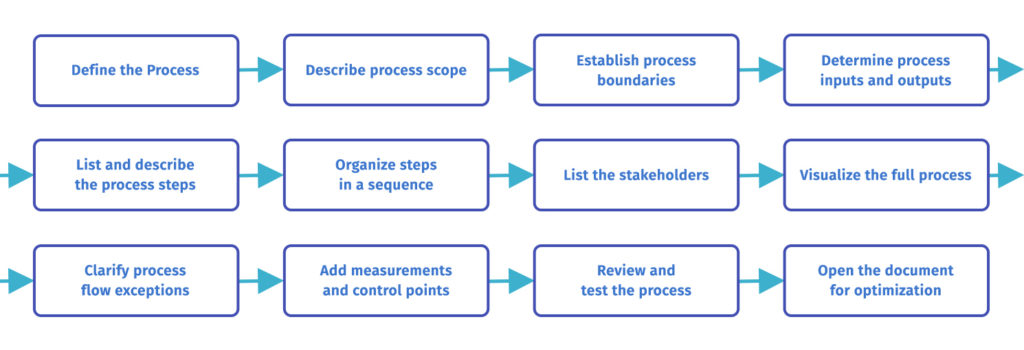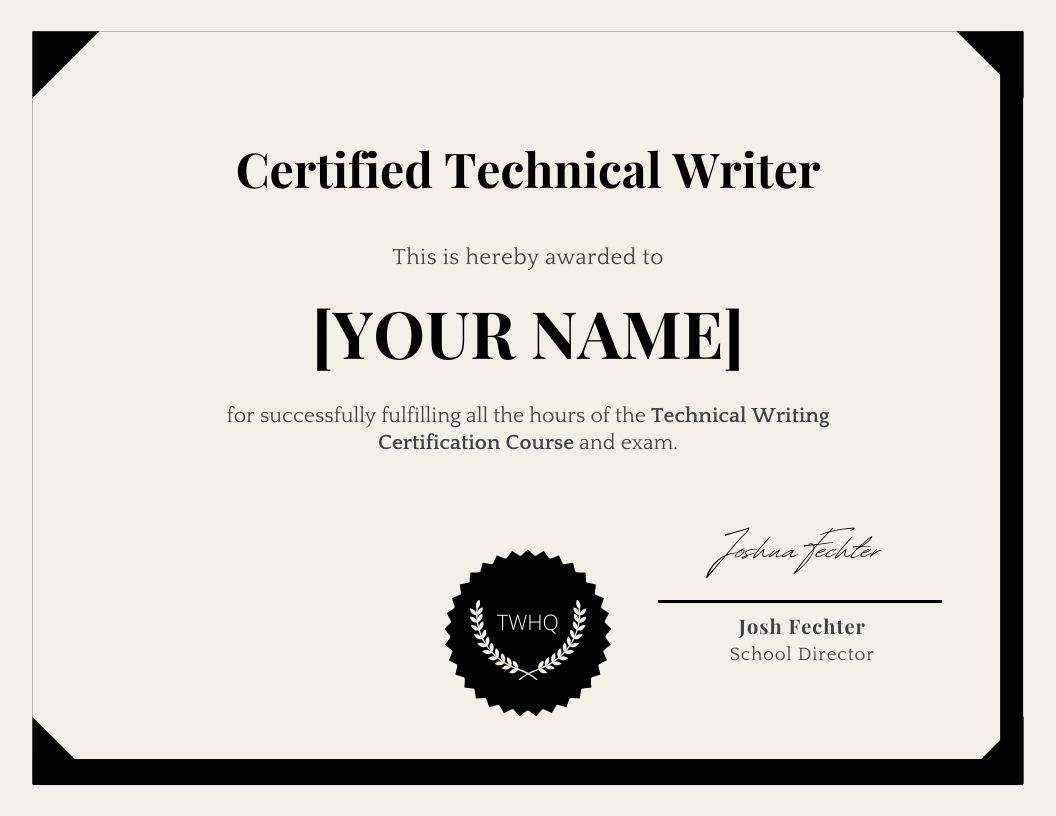Process documentation is the practice of recording and detailing the steps, workflows, and procedures involved in completing a task or business process. It is a reference guide to ensure consistency, efficiency, and standardization across an organization.
This type of documentation can include step-by-step instructions, flowcharts, checklists, and guidelines, making it easier for employees to follow complex processes correctly. Process documentation is essential for training new employees, improving operational efficiency, and ensuring compliance with company policies or industry regulations.
For example, a company may document its customer support workflow, outlining how tickets are received, assigned, and resolved. This documentation helps support teams maintain consistency and reduces the risk of errors, ultimately improving customer satisfaction.
What is Process Documentation?
Process documentation helps all major and minor stakeholders understand how a business or technical process works.
The documents included in the process are:
- Usage tutorials
- Policy papers
- Operation checklists
- Visual media (screenshots, flowcharts, and diagramming)
- Process maps/virtual workflow
- Links to other sources
The purpose of the documentation is to open the process up to all stakeholders and invite input for process improvement. Doing this helps departments optimize processes and instill consistency.
Process documentation captures one of the most important types of technical writing. Depending on the company producing it, it has varying templates.
A Step-by-Step Guide to Writing a Process Document

Here’s a detailed guide on how to put together a process document for any department.
1. Define the Process
Before developing documents, decide on which process to document first.
Once done, define it in as much detail as possible, including the document’s purpose, how it benefits the company, and how the process can be improved over time.
Create a separate document with these details for guidance during the primary business process documentation.
2. Describe the Process Scope
Once you have a clear description and purpose, work on defining the short and long-term project scope.
The project scope consists of basic details such as the number of tasks and whether each task will cover a single business process or a series of processes.
The scope should also be a separate document, especially for more complicated processes that will have a bigger impact on business outcomes.
3. Establish Process Boundaries
Describe the parameters and boundaries of the actual process, including the starting and endpoints, as well as what causes the process to start and end.
Define each trigger in detail. This will allow all stakeholders to plan successive processes around this one and gauge whether automation can streamline the process.
Additionally, define the start and end point of each step of the process. This will allow the technical staff to see if the number of steps can be reduced to reach the decided outcome.
If you want to become an expert at creating comprehensive process documentation, check out our technical writing certification courses.
4. Determine the Process Inputs and Outputs
Explain the number and types of resources needed to perform each step.
This will help the resource management team determine how to structure the resource input for maximum gain and project the cost-to-benefit ratio for each process step.
In the long run, process owners and company leadership can track these numbers to optimize current processes and make smarter process decisions.
5. List and Describe the Process Steps
Once you have the process foundation, start brainstorming the activities and operations needed to complete each step.
Some companies take this step before establishing process boundaries while documenting. This may be according to their standard operating procedures, although it’s preferred to establish boundaries first so that any step doesn’t take up more time and resources than necessary.
The brainstorming part of the process should include all the people with extensive know-how of the company’s business needs, documenting SOPs and all the different ongoing processes.
6. Organize Steps in a Sequence
The next step is to organize the steps into the optimal sequence to create a smooth workflow.
To do this, consider which step follows which. Devise ways to reduce the gap between each step by implementing more efficient activities.
While doing this, identify which steps follow each other and which go together as parallel activities. Group the latter ones together, and if a step contains more than one activity (or two conjoined ones), break it up into two steps.
7. List the Stakeholders
Describe all the staff members involved in the process (and process documentation). Define their roles in the process and mention their official titles and their individual progress.
While listing the personnel, clarify each person’s roles according to their referential capacity in case they want to reference the document later.
8. Visualize the Full Process
An important part of creating an effective document is visualizing the full process and optimizing it from a visual standpoint.
This will create a mental flowchart of the process in your mind and improve its readability and clarity.
If the documentation is graphic-heavy, create a uniform image of the full process in your mind and create all the charts, metrics, and diagrams according to one design principle.
9. Clarify Process Flow Exceptions
Considering future process modifications, it’s important to mention any and all steps that might be exceptions to the ones listed in the documentation.
This is a future-proofing method that allows the process to be streamlined in the future. If a new tech product or automation measure comes up, process owners need to be able to implement it without causing extensive revisions.
10. Add Measurements and Control Points
Identify the areas in the process that are most prone to risks and insert control points to help key process personnel monitor (and modify) the process as needed.
Also, create measurement procedures that determine the overall effectiveness of the process. This allows key stakeholders to track the process’s performance and implement improvements that best suit the process flow.
11. Test and Review the Process
Once you have completed the process, bring together all the stakeholders and review the documentation.
Open the process map to suggestions and critique and look for missing steps, miscalculations, steps out of order, or general errors. Once the process is ready, test it and check if anything is missing or consuming more resources than necessary.
12. Open the Document for Optimization
Lastly, take the completed process documentation set and send it to technical experts for review and optimization.
Your process documents guide the process and inform everyone involved of its expected outcomes at every stage. Continue making adjustments as you identify more streamlined activities.
Top Process Documentation Benefits
Process documentation benefits companies of any size, including the obvious increase in workflow streamlining and the ability to improve business process management.
Here are a few important ones:
- Process documentation helps bring the team on the same page regarding a specific business process. It provides a synchronized view of the process steps, which instills consistency.
- It helps identify inefficiencies and process bottlenecks that might go unnoticed if the company implements a process directly. In real-time, it lays out all the decision points for anyone with suggestions for improving the process.
- By documenting a process, companies can save time on current and future operations by removing any confusion regarding any steps and providing all stakeholders with a clear view of the company’s vision.
- Documentation improves the overall quality of the processes as well as the outcome of the processes. This means that companies can improve how they approach each step of the process, create better solutions to complicated procedures, and reduce costs.
- It helps with training and onboarding new employees, demonstrating their job roles more clearly, and giving them a virtual process map that helps them adapt. Even when the employees gain experience with the company, they can refer to the documents for more process knowledge.
Additionally, documentation reduces the risk of intra-process failure. This is due to its transparency and ability to allow experts to have a say in optimization and risk mitigation.
How to Produce Detailed and Effective Process Documentation
Here is how to be efficient when you write process documentation:
- Define & Use Process Documentation Software: Use one of the many BPM and process documentation tools, such as Lucidchart, and documentation software, such as Microsoft Visio and Excel.
- Make it Concise: Create documents as streamlined and to the point as possible. Remove anything that can be removed without affecting the overall quality of the process or the outcome.
- Update When Needed: If the process requires a new step or you have discovered a more efficient way to complete a step, make sure to implement the update in the documentation promptly.
- Store in a Centralized Location: Always have a centralized storage location for all processes and supplementary documents, such as diagrams, case studies, and more. Several tools provide access to singular cloud storage as an enterprise package.
- Use Visual Aids: Make the documentation visually appealing and insert graphics to explain metrics and numbers better. Furthermore, color coding and multiple platforms explain different activity levels.
- Synchronize with Company Standards: Ensure that all documentation is unique to the company’s operational standards and processes. Customize the design of the documentation according to company design standards as well.
- Add Swim Lane Diagrams: Where appropriate, add swim lane diagrams to distinguish the different roles, process steps, timelines, and resource input.
- Try Optimized Cost-Cutting: Look for more cost-effective activities and programs that don’t affect the quality of the documentation or the intended outcome.
- Create Templates and Style Guides: If you have a documentation process that has worked for you or one that you have recently optimized, use that as a template or create a style guide out of it to help recruits start using it immediately.
- Create Individual Documents: Instead of compiling everything into one big document, create multiple smaller ones for different processes. If you think one process deviates from another even slightly, create separate documentation for it.
In addition to the above, use any existing documents to reinforce your documentation and add value.
Existing documents could include interview transcripts, case studies, records, field diaries of project stakeholders, and any other documented process knowledge accumulated over time.
Final Thoughts
Regardless of how many processes are ongoing at any one time, process documentation should be a common and mandatory practice at any company. It’s one of the best ways to ensure all business processes have some measure of future-proofing.
In conclusion, utilize the documentation set as an invaluable asset and give it just as much importance as other sets of paperwork.
FAQs
Here are frequently asked questions about process documentation.
What is process documentation?
Process documentation refers to creating detailed records of the steps, tasks, and activities involved in completing a business process. This documentation outlines how a method works from start to finish, ensuring that all team members clearly understand the workflow. It helps maintain consistency, improve efficiency, and provide quality control within an organization.
Why is process documentation necessary?
Process documentation serves several critical purposes in an organization. It helps to standardize operations, ensuring that tasks are completed consistently. This improves efficiency and productivity, as team members can easily follow established procedures. Additionally, process documentation is essential for training new employees, reducing the learning curve, and ensuring everyone is on the same page. It also aids in identifying areas for improvement and streamlining workflows.
What are some common process documentation tools?
Various tools can help create and manage detailed process documentation. Some popular tools include flowchart software, project management tools, and specialized documentation software like Microsoft Visio, Lucidchart, and Confluence. These tools provide templates, collaboration features, and integration with other systems to make the documentation process more efficient and effective.
How do you create well-documented processes?
To document process outputs and inputs, start by identifying the process that needs to be documented and gather all relevant information. Break down the process into individual steps and record each step in detail. Use visuals like a process document flowchart or diagrams to illustrate the workflow. Ensure the documentation is clear, concise, and easily accessible to all team members. Review and update the documentation to reflect any changes in the process. Engaging with team members directly involved in the process can provide valuable insights and ensure accuracy.
If you are new to technical writing, we recommend taking our Technical Writing Certification Course. In it, you will learn the fundamentals of being a technical writer, how to dominate technical writer interviews, and how to stand out as a technical writing candidate.







